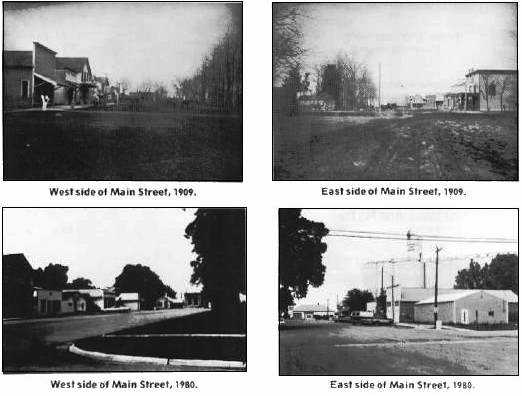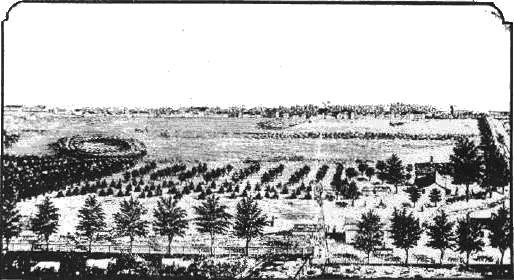|
|
down the centerline, each being 75 feet wide and one
block long. These were planted to several varieties of trees
and now, 100 years later, many of them are still living and
of great size. Most of them are catalpa, but there are also
hackberry, sycamore and black locust. The many very large
American Elms succumbed to the Dutch Elm disease in more
recent years. These trees provided shade for the horses at
the hitching rails along main street in the earlier years
and for the autos in more recent years and for the people
throughout all the years.
In about 1915 a well-designed bandstand
was built in the north park. This was well lighted and
enclosed with screen. The Bellwood band held concerts every
Saturday evening during the summer. This was open night for
all the stores and the business district was usually quite
crowded with people and the hitching rails with horses.
The first street lights in the business
district were acetylene gas. The gas generator plant was
located a short distance north of the present Co-op service
station in block 2. These were installed some time in the
late 1880's or early 1890's
About 1900 Biney Curtis constructed the
first electric plant. This set at the south end of the north
centerpark. The plant was a 110-volt direct current dynamo
run by a flat belt from a gasoline engine. This did not
provide continuous service, but was started up at dusk and
shut off at 10:30 p.m. Service was provided for all the
homes and business places in town who subscribed for it.
This plant burned to the ground in the early morning hours
in about 1915. Shortly thereafter the village erected a
larger generating plant, also 110-volt D. C., which was
housed in the concrete block building on the NW part of
block 2 now used for the city water pressure equipment. When
the Iowa-Nebraska Power Company ran a high voltage line into
town in the early 1920's, this electric plant was taken out
of service.
When the townsite was laid out and
building got under way, the Ladies Aid Society was asked to
propose a name for the town. Mary Finch proposed the name of
Bells Woods due to the great many trees that J. D. Bell had
planted. Shortly thereafter, the name of Bellwood appeared
on the new depot and Bellwood it stayed
People in the locality had been getting
their mail at a post office called PATRON that was located
on the east side of the section road directly east of the
present grain elevators. The first post office in Bellwood
was located in the front of E. F. Hutchinson's general store
and Mr. Hutchinson was the first postmaster. This store was
located on the southeast corner of block 13 where Chris and
Viola Kamenske now live.
The town got off to a quick start with
construction of homes and business places. Lots were selling
for $20 to $50. In the fall of 1881 J. D. Bell erected a
large 2-story general merchandise store on the southwest
part of block 2 where the Co-op Service Center is now
located. The second floor was designed for gatherings and
was used for meetings, church, Sunday School and social
events. A number of rather prominent entertainers appeared
on the stage there before the turn of the century.
The J. D. Bell store was quite successful
from the start, attracting customers from a broad area. At
times the business required 7 clerks to wait on
customers.
The town grew rapidly and in 1883 Mr. Bell
had a new addition of 22 blocks surveyed and were soon ready
for sale. The following tabulation of U. S. census figures
for Bellwood is of interest.
1880-zero 1910-397 1940-434 1970-361
1890-413 1920-369 1950-389 1980-401
1900-410 1930-391 1960-361
The drop in population following the first World War was
partly due to the returning soldiers finding opportunities
elsewhere. Also due to the rapid increase in the use of
automobiles and improved roads the population everywhere
became more mobile. The peak of 434 in 1940 was, no doubt,
due to the great depression of the 1930's and the consequent
lack of opportunities in the cities.
Mr. Bell had a number of plans to enhance
the business
|
|
opportunities of the community, but
his untimely death following a brief illness in 1889 brought
most of his plans to a halt.
Bellwood-Ideal
Home
Of The Farmer
Bellwood
Gazette, Nov. 13, 1896 Bellwood, Nebr., a
progressive little city of 500 population situated on the B
& M Railroad.
CROPS
Corn is King and the average yield is 60
bushels per acre and of the best quality. Oats is superior
and yield is 50 to 80 bushels per acre. Wheat and rye do
especially well, too.
SOILS AND STREAMS
Geological writer, Owen, described the
land as resembling the loamy deposits in the Nile Valley,
famous the world over for its richness. The principal stream
is the Platte River which affords a most excellent water and
drainage system.
BELLWOOD
A lively little city of 500 population,
and with an excellent reputation as a trading post, is this
town of Bellwood. Its merchants and citizens are a hustling
and enterprising group with a determination to succeed in
their work.
PUBLIC SCHOOLS
Bellwood had a fine two-story frame school
building erected at the cost of about $5,000. Professor C.
E. Shea is in charge of the school with his assistants, Miss
Friend and Miss Stork. There are 117 pupils.
CHURCHES
Various religious denominations are
established here for the spiritual good of the families of
our city. The Methodist, Catholic, and Baptist Churches are
all flourishing.
SHIPPING FACILITIES
J. Francis and W. H. Garwood are in charge
of the shipping company's business for the past four years.
Mr. Garwood is also operator for the Western Union Telegraph
Co. and is the agent for the Adams Express Co.
THE GAZETTE
Under the name, The Gazette, a neat,
well-edited and creditable newspaper is issued weekly.
BANKING INTERESTS
The Platte Valley State Bank was
established here in 1884 by Dave Beisley and in 1885 was
purchased by H.R. Gould. Officers were H. R. Gould, Pres.,
A. H. Gould, Cashier, and R. C. Gould, Assistant Cashier. A
judicious, conservative banking business was carried on,
interest was paid on time deposits, good bankable paper was
negotiated, and insurance was written. The bank would also
buy and sell land and made available farm loans. It was
noted to be a solid and reliable monied institution and
worthy of unlimited public confidence.
C. J. KNUTZEN
He owns the leading and largest store in
the city and came here from Saunders County, where he had 14
years experience. His general store has groceries, dry
goods, as well as boots and shoes for the family.
J. C. HAGER
Mr. Hager is a carriage maker and
carpenter. He assisted with the erection of the Bellwood
depot in 1880. He also is an agent for Butler Co. lumber
dealer, W. A. Wells of David
|
|

